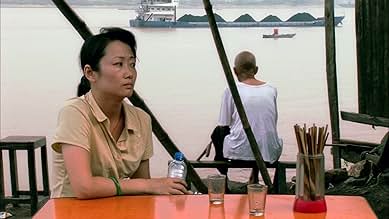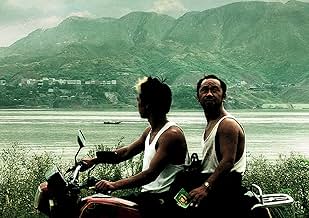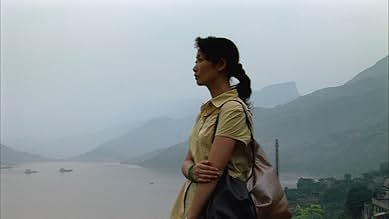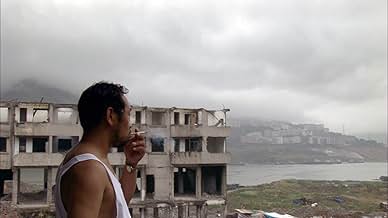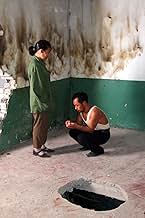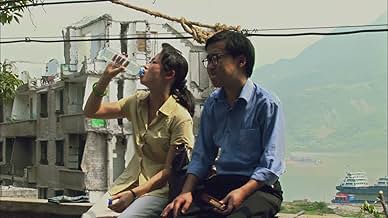IMDb RATING
7.3/10
7.7K
YOUR RATING
A town in Fengjie county is gradually being demolished and flooded to make way for the Three Gorges Dam. A man and woman visit the town to locate their estranged spouses, and become witness ... Read allA town in Fengjie county is gradually being demolished and flooded to make way for the Three Gorges Dam. A man and woman visit the town to locate their estranged spouses, and become witness to the societal changes.A town in Fengjie county is gradually being demolished and flooded to make way for the Three Gorges Dam. A man and woman visit the town to locate their estranged spouses, and become witness to the societal changes.
- Awards
- 15 wins & 14 nominations total
- Director
- Writers
- All cast & crew
- Production, box office & more at IMDbPro
Featured reviews
Ancient towns have been submerged along the Yangtse River in China as part of the Three Gorges Dam project. Jia Zhang-Ke has created a contemplative and compassionate human drama set in the region, depicting two separate protagonists attempting to locate missing ones who lived in areas now underwater.
I'm not a great fan of high definition digital video photography, but this sublime film takes advantage of the benefits of the technology while avoiding most of the pitfalls. I was seriously sleep-deprived while watching the film and never got close to nodding off, even though there are very long takes where little seems to happen. Yet in takes, there are many passing details, the beautiful movements of camera taking in rich and authentic details of people, situations, implements, household paraphernalia and gorgeous sweeping vistas. The latter appeared to be enhanced using filters, which seemed to compensate for the loss of aesthetics that comes from not shooting on 35mm film. This film was visually beautiful, though that really only served what was an extremely well-made film.
As a lover of world cinema, I found the attention to detail fascinating. The director seemed to be sharing the idiosyncrasies of the local culture, customs and demeanour with a real sense of compassion and humanitarianism. I found it poetic, uplifting and moving. Paraphrasing Melbourne International Film Festival executive director Richard Moore's in introduction by quoting the director (who was in attendance as a guest of the festival): "I originally wanted to make films that would change the world... I now realise this is not possible, and I just wish to make films that make people sigh." It worked on me.
I'm not a great fan of high definition digital video photography, but this sublime film takes advantage of the benefits of the technology while avoiding most of the pitfalls. I was seriously sleep-deprived while watching the film and never got close to nodding off, even though there are very long takes where little seems to happen. Yet in takes, there are many passing details, the beautiful movements of camera taking in rich and authentic details of people, situations, implements, household paraphernalia and gorgeous sweeping vistas. The latter appeared to be enhanced using filters, which seemed to compensate for the loss of aesthetics that comes from not shooting on 35mm film. This film was visually beautiful, though that really only served what was an extremely well-made film.
As a lover of world cinema, I found the attention to detail fascinating. The director seemed to be sharing the idiosyncrasies of the local culture, customs and demeanour with a real sense of compassion and humanitarianism. I found it poetic, uplifting and moving. Paraphrasing Melbourne International Film Festival executive director Richard Moore's in introduction by quoting the director (who was in attendance as a guest of the festival): "I originally wanted to make films that would change the world... I now realise this is not possible, and I just wish to make films that make people sigh." It worked on me.
The movie tells two separate stories of two people. They are both from Shaanxi and take a long way to Fengjie to find their relatives. As they came to Fengjie, a 2000 year old city was going to submerge under water as the great Three Georges Dam was being built. Even though the media always tells great things about the Three Georges Dam, what the audience actually see is a dying town which is being demolished part by part. Along with the city is the destinies of poor people living here. People were forced to relocate and find another place to live and work. The movie is also very successful to depict the miserable living condition of poor people in the region. From here, another aspect of Chinese economic miracle is revealed as poor people find no way to get out of deadly spiral of poverty and have no choice but to move to other places such as Shaanxi to work as coal miners - a job as described in the movie can help them earn more money than their hometown but is also riskier as dozens of people die every year.
Another success of the film is the choice of music and songs that were played intermittently during the movie. In particular, the old song "Seung Hoi Tan" was used as a ringing tone for the phone of a local worker, perhaps as a reminder of old traditional value. On the other hand, "Mouse Love Rice" - a new rising love song at that time was singed passionately by the young kid marking the subtle transform in Chinese culture.
Another success of the film is the choice of music and songs that were played intermittently during the movie. In particular, the old song "Seung Hoi Tan" was used as a ringing tone for the phone of a local worker, perhaps as a reminder of old traditional value. On the other hand, "Mouse Love Rice" - a new rising love song at that time was singed passionately by the young kid marking the subtle transform in Chinese culture.
Though perhaps 'Still Life'/'Sanxia haoren' (the Variety reviewer thought so) is primarily for the Jia devotee or the festival-goer (it's already been awarded the Golden Lion at Venice) and certainly it's totally noncommercial, it's a lovely, hypnotic piece of work, another haunting picture of the vast creation, disruption, destruction that is modern China from that country's most exciting and original younger-generation filmmaker.
There are layers of irony in the title, because in the incredibly turbulent, ceaselessly active events on screen in this world of life that is anything but "still," the most amazing images slip by without comment. A construction boss on a rampart one evening cell-phones a technician and says, "The VIP's are here. Why aren't the lights on? I'll count to three; then turn on. One, two, three. . ." and a huge bridge and arch are suddenly illuminated behind him. One of the two estranged couples the film follows to tentative reunions is talking with a vast city behind them and in the background a big skyscraper suddenly, silently collapses. There is no comment. It just miraculously happens. In the final shot, amid the debris of the Three Gorges where the world's largest dam will eventually displace 1.4 million people, Han Sanming (non-actor Han Sanming's actual name), a mine worker who's come to find his wife and daughter, who left him sixteen years ago, stands looking out at the urban landscape and a trapeze artist is quietly walking across a tightrope between tall buildings. Again, no comment.
Han Sanming can't find his wife right away and her brother doesn't trust him at first, so he stays for months, working with the brother in demolition. A perky young fellow, who quotes John Wu star Chow Yun Fat and imitates Hong Kong gangster gestures, befriends Han Sanming and they put each other's numbers in their cell phones--a contemporary pledge of solidarity that has a sad sequel later. The young fellow, who could easily have been one of the lost, hopeful young men in Jia's 2002 Unknown Pleasures, is lost in a demolition accident and gets a sea burial like the one accorded to Johnny Depp's character in Jim Jarmusch's Dead Man.
Focused on the displacement of people for a vast industrial and engineering project, Still Life also contrasts classes--the humble working-class stiff who can make 50 yuan a day pulling down walls or 200 going down in a coal mine not knowing if he'll come back out, versus the handsome lady, Shen Hong (Zhao Tao) whose estranged building magnate husband she wants to divorce because she's found a younger man. She has options; Han Sanming is simply drifting and lonely. And in the background for both, though, is the enormous turbulence and activity in which we see both protagonists as tiny helpless figures, their own lives indeed "still life" by comparison.
There's another unexpected, astonishing sequence of a fat rock singer, naked from the waist up like most of the Three Gorges demolition workers Han Sanming encounters and drenched in sweat. He sings of nostalgia for his youth, a time when everybody was happy , and old men in the audience shed tears while garish go-go girls gyrate: where does this fit in? This is another symbol of social upheaval. But what is really happening? Won't Chinese society have to return to its heritage of Mao and the Eighties aftermath chronicled in another of Jia's unwieldy masterpieces, the 2000 Platform? Perhaps the titles Still Life ironically points to the way people are frozen in isolation (broken couples, estranged children) and unhappiness (or quiet desperation) in a China that all the rampant economic progress both masks and perpetuates.
After his colorful land pointed but somewhat leaden 2004 The World/Shijie Jia Zhang-Ke has shown again as in Platform and Unknown Pleasures that he can touch and astonish. The human events are dwarfed by capitalist Progress in the new China, but people (after all, they are a zillion of them there) are still very much in the foreground. \Still Life is an impressive, organic-feeling movie that refers to Jia's earlier films but, extraordinarily, seems to bring together both post-war Italian neo-realism and the desolate urban landscapes of Michelangelo Antonioni.
Seen in Paris, October 21, 2007 at the MK2 Hautefeuille.
There are layers of irony in the title, because in the incredibly turbulent, ceaselessly active events on screen in this world of life that is anything but "still," the most amazing images slip by without comment. A construction boss on a rampart one evening cell-phones a technician and says, "The VIP's are here. Why aren't the lights on? I'll count to three; then turn on. One, two, three. . ." and a huge bridge and arch are suddenly illuminated behind him. One of the two estranged couples the film follows to tentative reunions is talking with a vast city behind them and in the background a big skyscraper suddenly, silently collapses. There is no comment. It just miraculously happens. In the final shot, amid the debris of the Three Gorges where the world's largest dam will eventually displace 1.4 million people, Han Sanming (non-actor Han Sanming's actual name), a mine worker who's come to find his wife and daughter, who left him sixteen years ago, stands looking out at the urban landscape and a trapeze artist is quietly walking across a tightrope between tall buildings. Again, no comment.
Han Sanming can't find his wife right away and her brother doesn't trust him at first, so he stays for months, working with the brother in demolition. A perky young fellow, who quotes John Wu star Chow Yun Fat and imitates Hong Kong gangster gestures, befriends Han Sanming and they put each other's numbers in their cell phones--a contemporary pledge of solidarity that has a sad sequel later. The young fellow, who could easily have been one of the lost, hopeful young men in Jia's 2002 Unknown Pleasures, is lost in a demolition accident and gets a sea burial like the one accorded to Johnny Depp's character in Jim Jarmusch's Dead Man.
Focused on the displacement of people for a vast industrial and engineering project, Still Life also contrasts classes--the humble working-class stiff who can make 50 yuan a day pulling down walls or 200 going down in a coal mine not knowing if he'll come back out, versus the handsome lady, Shen Hong (Zhao Tao) whose estranged building magnate husband she wants to divorce because she's found a younger man. She has options; Han Sanming is simply drifting and lonely. And in the background for both, though, is the enormous turbulence and activity in which we see both protagonists as tiny helpless figures, their own lives indeed "still life" by comparison.
There's another unexpected, astonishing sequence of a fat rock singer, naked from the waist up like most of the Three Gorges demolition workers Han Sanming encounters and drenched in sweat. He sings of nostalgia for his youth, a time when everybody was happy , and old men in the audience shed tears while garish go-go girls gyrate: where does this fit in? This is another symbol of social upheaval. But what is really happening? Won't Chinese society have to return to its heritage of Mao and the Eighties aftermath chronicled in another of Jia's unwieldy masterpieces, the 2000 Platform? Perhaps the titles Still Life ironically points to the way people are frozen in isolation (broken couples, estranged children) and unhappiness (or quiet desperation) in a China that all the rampant economic progress both masks and perpetuates.
After his colorful land pointed but somewhat leaden 2004 The World/Shijie Jia Zhang-Ke has shown again as in Platform and Unknown Pleasures that he can touch and astonish. The human events are dwarfed by capitalist Progress in the new China, but people (after all, they are a zillion of them there) are still very much in the foreground. \Still Life is an impressive, organic-feeling movie that refers to Jia's earlier films but, extraordinarily, seems to bring together both post-war Italian neo-realism and the desolate urban landscapes of Michelangelo Antonioni.
Seen in Paris, October 21, 2007 at the MK2 Hautefeuille.
This week China announced that about 300,000 more people than planned will be relocated as a result of the construction of the Three Gorges Dam on the Yangtze River, bringing the total displaced to more than 1.4 million. The $22.5-billion US dam, a mega-project five times the size of the Hoover Dam, which has been heavily criticized by environmental and human rights groups, was begun in 1993 but will not go into full operation until 2008. The project's effect on ordinary Chinese is the focus of Jia Zhangke's latest film, Still Life, the surprise winner of the Golden Lion Award at this year's Venice Film Festival.
Set in the village of Fengjie, since submerged in water to make way for the dam, Jia's slow-paced, class-conscious effort dramatizes the life of villagers who have been forced from their homes, had their traditional way of life destroyed, and sent to live in cities against their will, often having to resort to begging and garbage collecting, or even prostitution to stay alive. The film, along with its companion documentary Dong, tells overlapping stories of the emotional trauma of local people caught in the dislocation at Fengjie while a new village is being built.
In the first sequence, Han Sanming, a middle-aged coal miner from Jia's home Shanxi province, arrives on a ferry to look for his ex-wife, Missy after sixteen years of estrangement. All he has to rely on is an address given to him many years ago, completely unaware of the demolition and flooding in the area. Avoiding local swindlers, he tracks down Missy's uncle who tells him that his former wife is now in Yichang with his teenage daughter. Staying on to work in the demolition projects, Han engages in conversations with other workers who complain of the low wages they are receiving (60 to 70 Yuan a day) and want to return to Shanxi province with Han where they can earn 200 Yuan a day working in the dangerous coal mines.
In the second story, Shen Hong (Zhao Tao), a nurse arrives from Shanxi as well and is also searching for a missing person, her husband Guo Bin, who left the family two years ago. She is aided in her search by archaeologist Wang Dongming but it is uncertain what course of action Shen has in mind when she reunites with her husband. The film, however, is not about the story line but about the landscape and the atmosphere, playfully charged by the CG appearance of a UFO and a spaceship that takes off in the middle of the rubble.
In Still Life, Jia demonstrates to the world how one of China's most gorgeous areas, one that brings in 1.3 million tourists a year, has become a scene of squalor. Jia says: "We all know there is major change going on in China and I wanted to get more people to know what's happening. I will continue to make films along these lines and explore the problems of the weaker social classes." If Jia's future projects contain the unmatched cinematography, compelling story, and characters whose lives touch us as Still Life, we have much to look forward to.
Set in the village of Fengjie, since submerged in water to make way for the dam, Jia's slow-paced, class-conscious effort dramatizes the life of villagers who have been forced from their homes, had their traditional way of life destroyed, and sent to live in cities against their will, often having to resort to begging and garbage collecting, or even prostitution to stay alive. The film, along with its companion documentary Dong, tells overlapping stories of the emotional trauma of local people caught in the dislocation at Fengjie while a new village is being built.
In the first sequence, Han Sanming, a middle-aged coal miner from Jia's home Shanxi province, arrives on a ferry to look for his ex-wife, Missy after sixteen years of estrangement. All he has to rely on is an address given to him many years ago, completely unaware of the demolition and flooding in the area. Avoiding local swindlers, he tracks down Missy's uncle who tells him that his former wife is now in Yichang with his teenage daughter. Staying on to work in the demolition projects, Han engages in conversations with other workers who complain of the low wages they are receiving (60 to 70 Yuan a day) and want to return to Shanxi province with Han where they can earn 200 Yuan a day working in the dangerous coal mines.
In the second story, Shen Hong (Zhao Tao), a nurse arrives from Shanxi as well and is also searching for a missing person, her husband Guo Bin, who left the family two years ago. She is aided in her search by archaeologist Wang Dongming but it is uncertain what course of action Shen has in mind when she reunites with her husband. The film, however, is not about the story line but about the landscape and the atmosphere, playfully charged by the CG appearance of a UFO and a spaceship that takes off in the middle of the rubble.
In Still Life, Jia demonstrates to the world how one of China's most gorgeous areas, one that brings in 1.3 million tourists a year, has become a scene of squalor. Jia says: "We all know there is major change going on in China and I wanted to get more people to know what's happening. I will continue to make films along these lines and explore the problems of the weaker social classes." If Jia's future projects contain the unmatched cinematography, compelling story, and characters whose lives touch us as Still Life, we have much to look forward to.
China's sixth generation director Jia Zhang-ke's recent Golden Lion winner at Venice is slightly more accessible to the general audience than his previous work, although Shijie (2004) has been heading generally towards that direction. Unlike Xiao Wu (1997), which is completely devoid of story or plot, Still Life at least has a story (in fact two) of sorts but, to Jia credit, stays away from the conventional Hollywood melodrama formula. The last thing we need is another Hollywood-look-alike movie made by a Chinese director who gives up what he is good at to impersonate a Hollywood director. There are already too many.
The story of the Three Gorges Dam begs to be told. Jia tells it from a micro, personal angle, by weaving two separate stories together, with the Three Gorges Dam project not just as a backdrop, but also as a subject of enquiry. In polarized contrast to the gorgeous tourism posters, Jia's camera shows the devastation along the Gorges in a way that almost reminds you of the ruins in Polanski's "The pianist". In the two unrelated stories, two people arrive in the same riverside town, a nurse looking for her husband who seems to have lost interest in her, and a coalminer searching for his wife who left him, taking with her their daughter.
These stories are told in Jia's usual minimalist style, but with pain sticking attention to details. Instead of the dialogue, it's the nuances, the body language, and even the framing of the shot that reveals. New to Jia's screen are moments of playful, surprising touches as if the director is saying "Hey, I can handle surreal too". The appropriate use of pop music from Hong Kong, Taiwan and the Mainland of China adds to the dimension and depth of the film.
True to his tradition, Jia films the life of ordinary people just as it is. The coalminer in Still Life is one in real life, and a relative of Jia. He even uses his real name Han San-ming. True to his tradition again, Jia uses only one professional actor, Zhao Tao, but she is so good that you can't tell her apart from the rest of the "cast" in terms of being an authentic, ordinary person that Jia might have just picked from a crowd in the street.
I miss Jia's earlier work such a Xiao Wu, for its uniqueness and detached, realistic depiction of lives of real people. On the other hand, I don't mind his introduction of conventional "entertaining" elements, so long as he stops before, way before, succumbing to the senseless scramble of the Chinese 5th generation directors to capture the Hollywood market. Many a soul has been sold for fame and fortune.
The story of the Three Gorges Dam begs to be told. Jia tells it from a micro, personal angle, by weaving two separate stories together, with the Three Gorges Dam project not just as a backdrop, but also as a subject of enquiry. In polarized contrast to the gorgeous tourism posters, Jia's camera shows the devastation along the Gorges in a way that almost reminds you of the ruins in Polanski's "The pianist". In the two unrelated stories, two people arrive in the same riverside town, a nurse looking for her husband who seems to have lost interest in her, and a coalminer searching for his wife who left him, taking with her their daughter.
These stories are told in Jia's usual minimalist style, but with pain sticking attention to details. Instead of the dialogue, it's the nuances, the body language, and even the framing of the shot that reveals. New to Jia's screen are moments of playful, surprising touches as if the director is saying "Hey, I can handle surreal too". The appropriate use of pop music from Hong Kong, Taiwan and the Mainland of China adds to the dimension and depth of the film.
True to his tradition, Jia films the life of ordinary people just as it is. The coalminer in Still Life is one in real life, and a relative of Jia. He even uses his real name Han San-ming. True to his tradition again, Jia uses only one professional actor, Zhao Tao, but she is so good that you can't tell her apart from the rest of the "cast" in terms of being an authentic, ordinary person that Jia might have just picked from a crowd in the street.
I miss Jia's earlier work such a Xiao Wu, for its uniqueness and detached, realistic depiction of lives of real people. On the other hand, I don't mind his introduction of conventional "entertaining" elements, so long as he stops before, way before, succumbing to the senseless scramble of the Chinese 5th generation directors to capture the Hollywood market. Many a soul has been sold for fame and fortune.
Did you know
- TriviaRanked second in French film magazine Cahiers du cinéma's top 10 list of the best pictures of 2007, tied with Inland Empire (2006) and Boulevard de la mort (2007).
- ConnectionsFeatures Le syndicat du crime (1986)
- How long is Still Life?Powered by Alexa
Details
Box office
- Budget
- CN¥10,000,000 (estimated)
- Gross US & Canada
- $76,983
- Opening weekend US & Canada
- $12,744
- Jan 20, 2008
- Gross worldwide
- $2,504,465
- Runtime1 hour 51 minutes
- Color
- Sound mix
- Aspect ratio
- 1.78 : 1
Contribute to this page
Suggest an edit or add missing content




